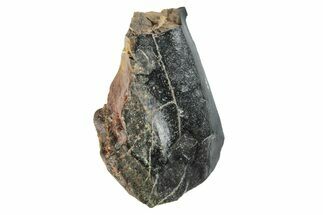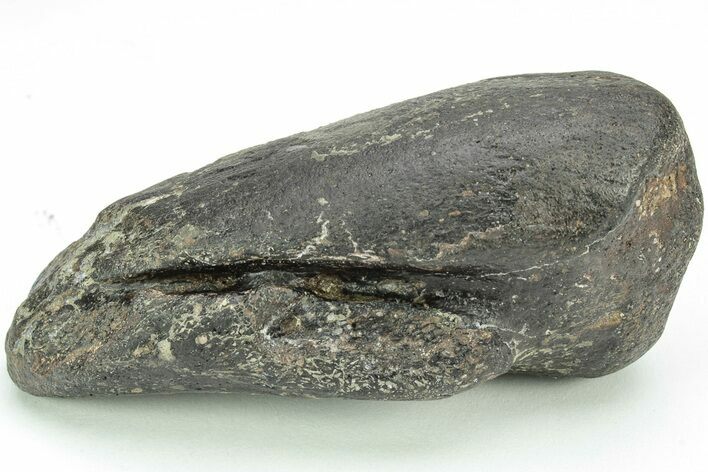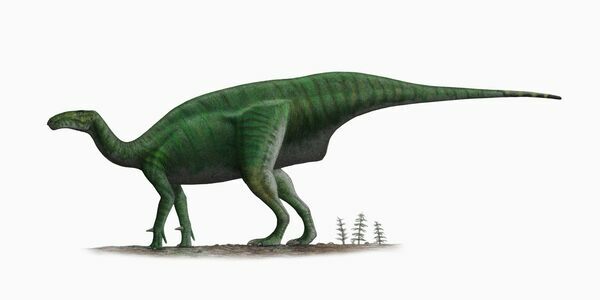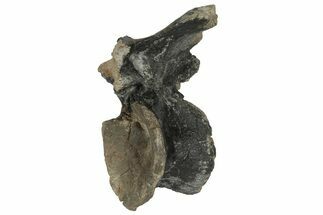This Specimen has been sold.
Very Rare, 3.2" Fossil Iguanodon (Mantellisaurus) Claw - England
This very unusual offering is the thumb claw of a Mantellisaurus atherfieldensis, an Iguanodon known to have roamed Belgium, England, Spain and Germany. It was collected from the Isle of Wight in England and is 3.2" long with no restoration or repair. As if this claw wasn't already spectacular enough, portions of this specimen are replaced by stable pyrite. British dinosaur material is extremely hard to come by and this is a fantastic collector piece.
About Mantellisaurus
Mantellisaurus is a genus of dinosaur formerly known as Iguanodon atherfieldensis that lived in the Barremian and early Aptian ages of the Early Cretaceous Period of Europe. Mantellisaurus was a lightly constructed iguanodont. Compared to Iguanodon bernissartensis, Mantellisaurus was smaller, estimated at about 1,600 pounds in weight.
It was a relatively large dinosaur, reaching lengths of about 6 to 8 meters (20 to 26 feet). It had a robust body, long neck, and a relatively small head compared to its body size. This dinosaur was bipedal and quadrupedal, meaning it could move on two legs or four, depending on the situation. Its long hind limbs were adapted for running, while its forelimbs were shorter. As a herbivore, Mantellisaurus primarily fed on low-lying plants, using its beak-like mouth to clip vegetation. Its teeth were suited for grinding and processing tough plant material. It had distinctively shaped teeth and a relatively long tail, which may have helped with balance and communication.
The first fossils attributed to Mantellisaurus were discovered in the 19th century, and the genus was named in honor of the British paleontologist Gideon Mantell. While initially classified as a species of Iguanodon, it was later recognized as a distinct genus based on its unique characteristics.
Mantellisaurus is a genus of dinosaur formerly known as Iguanodon atherfieldensis that lived in the Barremian and early Aptian ages of the Early Cretaceous Period of Europe. Mantellisaurus was a lightly constructed iguanodont. Compared to Iguanodon bernissartensis, Mantellisaurus was smaller, estimated at about 1,600 pounds in weight.
It was a relatively large dinosaur, reaching lengths of about 6 to 8 meters (20 to 26 feet). It had a robust body, long neck, and a relatively small head compared to its body size. This dinosaur was bipedal and quadrupedal, meaning it could move on two legs or four, depending on the situation. Its long hind limbs were adapted for running, while its forelimbs were shorter. As a herbivore, Mantellisaurus primarily fed on low-lying plants, using its beak-like mouth to clip vegetation. Its teeth were suited for grinding and processing tough plant material. It had distinctively shaped teeth and a relatively long tail, which may have helped with balance and communication.
The first fossils attributed to Mantellisaurus were discovered in the 19th century, and the genus was named in honor of the British paleontologist Gideon Mantell. While initially classified as a species of Iguanodon, it was later recognized as a distinct genus based on its unique characteristics.
SPECIES
Mantellisaurus (Iguanodon) atherfieldensis
LOCATION
Isle of Wight, England
FORMATION
Wessex Formation
SIZE
3.2" long
CATEGORY
SUB CATEGORY
ITEM
#206575
We guarantee the authenticity of all of our specimens.
 Reviews
Reviews
















